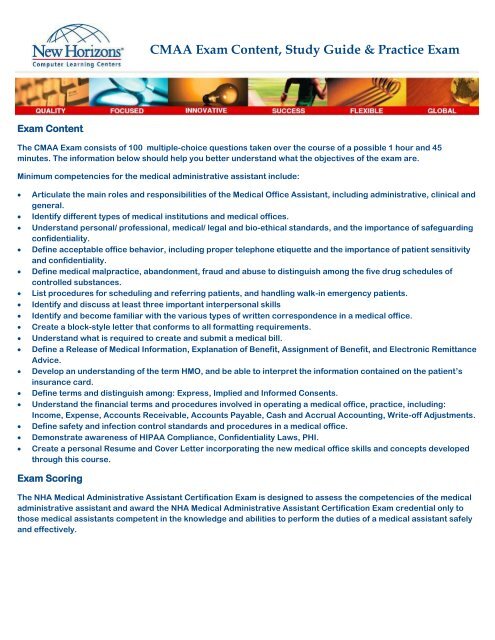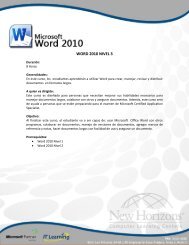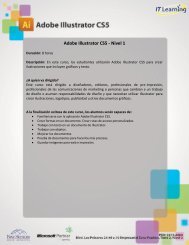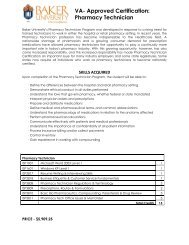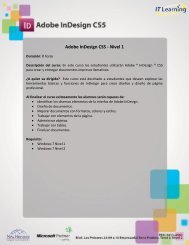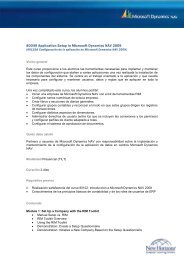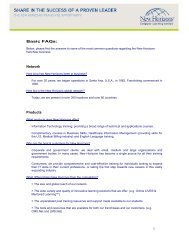CMAA Exam Content, Study Guide & Practice Exam - New Horizons ...
CMAA Exam Content, Study Guide & Practice Exam - New Horizons ...
CMAA Exam Content, Study Guide & Practice Exam - New Horizons ...
You also want an ePaper? Increase the reach of your titles
YUMPU automatically turns print PDFs into web optimized ePapers that Google loves.
<strong>CMAA</strong> <strong>Exam</strong> <strong>Content</strong>, <strong>Study</strong> <strong>Guide</strong> & <strong>Practice</strong> <strong>Exam</strong><br />
<strong>Exam</strong> <strong>Content</strong><br />
The <strong>CMAA</strong> <strong>Exam</strong> consists of 100 multiple-choice questions taken over the course of a possible 1 hour and 45<br />
minutes. The information below should help you better understand what the objectives of the exam are.<br />
Minimum competencies for the medical administrative assistant include:<br />
<br />
<br />
<br />
<br />
<br />
<br />
<br />
<br />
<br />
<br />
<br />
<br />
<br />
<br />
<br />
<br />
<br />
Articulate the main roles and responsibilities of the Medical Office Assistant, including administrative, clinical and<br />
general.<br />
Identify different types of medical institutions and medical offices.<br />
Understand personal/ professional, medical/ legal and bio-ethical standards, and the importance of safeguarding<br />
confidentiality.<br />
Define acceptable office behavior, including proper telephone etiquette and the importance of patient sensitivity<br />
and confidentiality.<br />
Define medical malpractice, abandonment, fraud and abuse to distinguish among the five drug schedules of<br />
controlled substances.<br />
List procedures for scheduling and referring patients, and handling walk-in emergency patients.<br />
Identify and discuss at least three important interpersonal skills<br />
Identify and become familiar with the various types of written correspondence in a medical office.<br />
Create a block-style letter that conforms to all formatting requirements.<br />
Understand what is required to create and submit a medical bill.<br />
Define a Release of Medical Information, Explanation of Benefit, Assignment of Benefit, and Electronic Remittance<br />
Advice.<br />
Develop an understanding of the term HMO, and be able to interpret the information contained on the patient’s<br />
insurance card.<br />
Define terms and distinguish among: Express, Implied and Informed Consents.<br />
Understand the financial terms and procedures involved in operating a medical office, practice, including:<br />
Income, Expense, Accounts Receivable, Accounts Payable, Cash and Accrual Accounting, Write-off Adjustments.<br />
Define safety and infection control standards and procedures in a medical office.<br />
Demonstrate awareness of HIPAA Compliance, Confidentiality Laws, PHI.<br />
Create a personal Resume and Cover Letter incorporating the new medical office skills and concepts developed<br />
through this course.<br />
<strong>Exam</strong> Scoring<br />
The NHA Medical Administrative Assistant Certification <strong>Exam</strong> is designed to assess the competencies of the medical<br />
administrative assistant and award the NHA Medical Administrative Assistant Certification <strong>Exam</strong> credential only to<br />
those medical assistants competent in the knowledge and abilities to perform the duties of a medical assistant safely<br />
and effectively.
<strong>CMAA</strong> <strong>Study</strong> <strong>Guide</strong><br />
The following study guide is meant to assist you in focusing on concepts tested in the certification exam. It is not<br />
intended to replace instruction and/or experience necessary for successfully completing the exam. You will note that<br />
some of the information is given to you –complete– and others are in question format that you must find the answers<br />
to– so that you can test yourself and study the answers.<br />
Appointment Scheduling<br />
<br />
<br />
<br />
<br />
<br />
What documentation is made and what steps do you take when a patient FAILS TO SHOW for their appointment.<br />
The abbreviation NP (when entering an appointment into the book) would mean?<br />
What information would you request from someone making their first appointment with your office, in order to schedule them?<br />
Know how to “mark out the book” with NON_PATIENT TIME (matrix)<br />
Understand the process for scheduling a surgery and what information should be entered into the appointment book<br />
Authorizations<br />
<br />
<br />
Authorization for the insurance carrier to pay the physician directly is called? Assignment of Benefits<br />
Know the form used that authorizes one physician to send information to another physician or facility. Release of Information<br />
Bookkeeping<br />
<br />
<br />
<br />
<br />
<br />
<br />
<br />
<br />
<br />
Understand how to calculate simple percentages; such as 80% of an amount or 20% of an amount.<br />
A Fixed Amount collected at the time of the visit is called a Co-Payment.<br />
When discounts are given to clergy or other professionals (such as physicians) it is called a “Professional Discount”<br />
Deductibles are PAID by the PATIENT– not the insurance company.<br />
What does “Bookkeeping in the Medical Office” generally consist of? Charges, payments and adjustments<br />
Understand the difference between a charge, payment and adjustment, what columns they should be placed in, and whether<br />
they are an “addition” or “subtraction” from the patient’s ledger.<br />
What process would you use to show an amount not allowed by an HMO, and not the responsibility of the patient’s ledger? See<br />
practice exam<br />
Know the “Bookkeeping Rule”; this helps you correctly add, subtract (calculate) entries to a patient’s ledger. Old Balance,<br />
Plus Charges, Minus Payments, Minus Adjustments, Equals <strong>New</strong> Balance<br />
What is the definition of the Accounts Receivables? See practice <strong>Exam</strong><br />
CEUs & Associations<br />
<br />
What are CEUs and why are they important?<br />
Communication Skills<br />
<br />
<br />
<br />
<br />
<br />
Know the difference between negative and positive, verbal and nonverbal behavior and expression.<br />
Computer & Computer File Maintenance<br />
Define a “hard copy” when referring to a document. See <strong>Practice</strong> <strong>Exam</strong><br />
How to make a copy of “stored information” on a computer for safekeeping. Back-up copy<br />
Define the components of a Network. Several computers linked and sharing information<br />
Confidentiality<br />
<br />
<br />
Know how to handle questions from others about a patient’s condition; remember information goes to the patient only unless<br />
there is a release of information signed. See <strong>Practice</strong> <strong>Exam</strong>.<br />
What are a few of the methods you can use to avoid a breach of patient confidentiality in the front office? Charts turned<br />
backward on doors; protection of sign-in sheets, computer screens protected from patient view<br />
Correspondence<br />
<br />
<br />
<br />
Correct way to write a doctor’s name on an inside address of a letter. First name, last name, comma M.D. (or MD)<br />
The best format to use for typing reports or letters is the one your physician prefers.<br />
Know ALL parts of a block style letter (correspondence); the format and the order in which information is presented. See<br />
<strong>Practice</strong> <strong>Exam</strong>
Understand the “spacing” requirement for various parts of a letter (correspondence).<br />
Documentation<br />
<br />
<br />
<br />
<br />
Know the SOAP method of documentation. See <strong>Practice</strong> <strong>Exam</strong><br />
Know the difference between Subject complaints and Objective Findings in the SOAP documentation. See <strong>Practice</strong> <strong>Exam</strong><br />
All entries in a medical record, or notations on a ledger, must be initialed by the person making the entry.<br />
Entries in the medical record should be made with black ink.<br />
Filing<br />
<br />
<br />
<br />
<br />
<br />
<br />
What are 3 most common filing methods? Alpha, Numeric, and Terminal Digit<br />
Know your filing Indexing orders so that you can correctly file alphabetically. See <strong>Practice</strong> <strong>Exam</strong><br />
Know the format for TERMINAL DIGIT filing. See <strong>Practice</strong> <strong>Exam</strong><br />
Understand the need for “Cross– Referencing” information for those with hyphenated names or more than one “last name”<br />
Understand NUMERICAL filing. See <strong>Practice</strong> <strong>Exam</strong><br />
Know what a “Tickler File” is.<br />
Law/ Ethics<br />
<br />
<br />
<br />
<br />
What is the meaning of arbitration (in medical environment). See <strong>Practice</strong> <strong>Exam</strong><br />
Know the Good Samaritan Law and what it is for.<br />
What must a physician do to terminate care of a patient so that he is not charged with abandonment? See <strong>Practice</strong> <strong>Exam</strong><br />
Know the difference between Implied Consent and Informed Consent. See <strong>Practice</strong> <strong>Exam</strong><br />
Mail<br />
<br />
<br />
<br />
<br />
<br />
What is the advantage of using Certified Mail? See <strong>Practice</strong> <strong>Exam</strong>.<br />
Understand what BULK MAILING is and how it is sorted. See <strong>Practice</strong> <strong>Exam</strong><br />
What is the Progress Note Sheet and what are the duties of the Medical Assistant to be sure it is prepared for the doctor for<br />
each visit? Room to write documentation, date stamped<br />
The tab of a patient chart usually contains what information?<br />
The Progress Not Sheet, in the patient’s chart, generally is kept on the TOP RIGHT side of the charge– with the most recent<br />
information always on top.<br />
Reception<br />
<br />
<br />
<br />
<br />
<br />
<br />
<br />
Greeting the patient ( as the receptionist)<br />
Receptionist should review all new patient information forms to be certain the patient has completed all necessary<br />
information.<br />
Protocol for notifying patients in waiting room that the doctor is running behind schedule. Notify aand allow them to wait or<br />
reschedule for another time<br />
What is the protocol for appearance as a medical assistant (in the front office setting)?<br />
What information is contained in the Patient Information Sheet?<br />
Which portion of the insurance card will you make a copy of for the patient’s file? See <strong>Practice</strong> <strong>Exam</strong>.<br />
How can you verify a patient’s insurance coverage?<br />
Reference Books<br />
<br />
Which book contains all prescription medication approved by the FDA with correct spelling and a lot of other information<br />
regarding the drug? See <strong>Practice</strong> <strong>Exam</strong><br />
Telephone<br />
<br />
<br />
<br />
<br />
<br />
<br />
Know what type of information should and SHOULD NOT be given out to patients and other callers.<br />
Know proper greetings when answering the phone in a medical office.<br />
Understand methods for dealing with angry callers (on the phone), in the medical office<br />
Understand the services provided by the Answering Service (or Exchange) in a medical office<br />
Understand how to handle emergency calls<br />
Know the content of information required for a complete telephone message
Understand the information needed and documentation needed when a prescription refill is completed by phone<br />
Terminology/ Word Parts<br />
<br />
<br />
<br />
<br />
<br />
<br />
<br />
<br />
<br />
<br />
<br />
<br />
<br />
<br />
<br />
<br />
<br />
<br />
<br />
Another word for throat is, See <strong>Practice</strong> <strong>Exam</strong><br />
Brady<br />
Chief Complaint, See <strong>Practice</strong> <strong>Exam</strong><br />
MI means?<br />
Neuro<br />
-ologist<br />
-oscopy means<br />
-pathy<br />
STAT means?<br />
Sub<br />
Suffix meaning inflammation<br />
The part of the urinary system that filters blood is called the<br />
How many chambers does the heart have? What are they?<br />
How many layers does the skin have and what are they?<br />
Another word for “skin” (as a system) is Integumentary<br />
CXR is a common abbreviation for Chest X-ray<br />
What is the common abbreviation for “cancer”?<br />
What is the common abbreviation for “diagnosis”?<br />
What does the combining form “hepato” mean?


